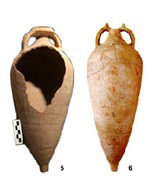Cargo ships
Trade involving the Cornus area is proven by images of trading ships landing at Korakodes Portus, wrecks found in the opposite gulf and imported items recovered during the digs. The main function of those trading ships was to transport goods distributed in a regular way, optimising space in the large hold (see fig. 1).

For example, an epigraphical tabula dated V century comes from the cemetery area of Columbaris; it must have been placed on the slab covering a sarcophagus. A Roman tradition merchant ship (fig.2), used with no changes from the late antiquity till the early Middle Ages, is engraved on the left side of the inscription.

The ship shows its lengthened hull, with flat keel, the mast (fusum) unfolds a squared sail (classic acatus) and there are two large rectangular oars. The sail panels indicate a lattice used to wind it up.
A second item comes from the same cemetery area. It is a brick fragment with a ship of the same type engraved on it (fig. 3).




Similar images found in Sardinia or concerning the island (figs. 4-5) all present cargo ships, except for the one case of the tile found in the Palace of the Barbarian King of Porto Torres, where they recognised a military ship with twenty-one oars.
Finding several ships and their cargo (for example amphorae) in the stretch of sea on the western coast of Sardinia proves the existence of trade routes from the Iberian Peninsula (fig. 6) towards the central-Italic ports, which foresaw intermediate stops including the Sardinian ports.

Bibliografia
- A. BONINU, Una nave in cotto da Porto Torres, in VII Settimana della Cultura Scientifica (Sassari 4-13 aprile 1997), Sassari 1997, pp. 96-98.
- M. I. MARCHETTI, F. R. STASOLLA, Le anfore, in A. M. GIUNTELLA (a cura di), Cornus I. 2. L'area cimiteriale orientale. I materiali = Mediterraneo tardoantico e medievale, 13. 2, Oristano 2000, pp. 305-339.
A. MASTINO, Cornus nella storia degli studi con un catalogo delle iscrizioni rinvenute nel territorio del comune di Cuglieri, Cagliari 1984, pp. 82, 84, 148. - D. SALVI, Macine e vetro nel relitto di Su Pallosu (San Vero Milis, Oristano), in A. MASTINO, P.G. SPANU, R. ZUCCA (a cura di), Tharros Felix 2, Roma 2006, pp. 155-163.
- E. SECHI, Il relitto di Sa Tonnara-A, in A. MASTINO, P.G. SPANU, R. ZUCCA (a cura di), Tharros Felix 2, Roma 2006, pp. 164-180.
- P. G. SPANU, Le navi di Cornus, in P. G. SPANU (a cura di), con la collaborazione di M. C. OPPO e A. BONINU, Insulae Christi. Il cristianesimo primitivo in Sardegna, Corsica e Baleari = Mediterraneo tardoantico e medievale. Scavi e ricerche 16, Oristano 2002, pp. 281-288.
- P. G. SPANU, Il relitto tardo-antico di Mandriola-A, in A. MASTINO, P.G. SPANU, R. ZUCCA (a cura di), Tharros Felix 2, Roma 2006, pp. 181-196.
- F. R. STASOLLA, Anfore orientali e iberiche, in M. I. MARCHETTI, F. R. STASOLLA, Le anfore, in A. M. GIUNTELLA (a cura di), Cornus I. 2. L'area cimiteriale orientale. I materiali = Mediterraneo tardoantico e medievale, 13. 2, Oristano 2000, pp. 305-339.
- R. ZUCCA, Inscriptiones parietariae Sardiniae in G. PACI (a cura di), Epigrafai. Miscellanea in onore di Lidio Gasperini, Tivoli 2000, pp. 1119-1132.

 VR
VR